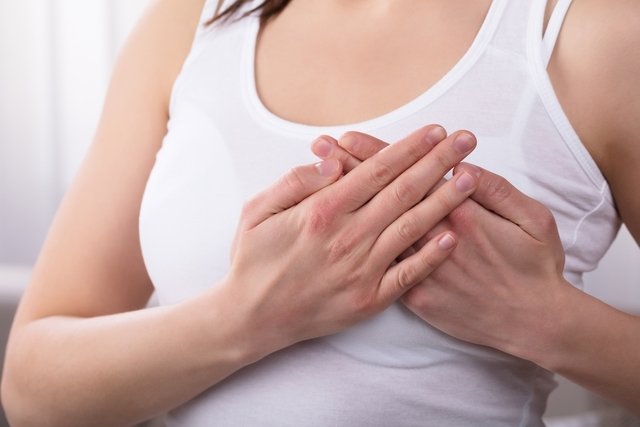Nipple pain is relatively common and can occur for various reasons in both men and women. Most times, it is a sign of a problem like excess friction from clothes, allergies or hormonal changes. It can also be a symptom of a more serious problem, like an infection or cancer.
Normally, nipple pain disappears within 2 or 3 days without any specific treatment. However, if pain lasts for longer or if the pain is very intense, you should see a doctor for assessment of the area and to identify the cause.
Learn about the 8 causes of nipple pain below:

1. Friction from clothes
This is the most common cause of nipple pain or itching. It usually emerges after physical activity, like running or jumping, as these quick movements can cause your shirt to rub repeatedly on the nipple, which can irritate the skin. In some cases of prolonged friction, a small wound or lesion can also emerge.
This problem can also occur in women who wear ill-fitting bras, or in people who wear clothes that are made of synthetic-based fabrics.
What to do: You should avoid using the type of material that caused the irritation if you were exercising. You can also place tape over the nipples to prevent friction. If you have a wound, you should cleanse the area and treat as necessary. A moisturizing cream may be helpful for healing.
2. Allergy
Nipples are one of the most sensitive areas of the body and they are highly responsive to small changes, like temperature, body soaps or even the type of clothes you use. With allergies, it is more common to feel itchiness, but you may also notice redness, skin peeling and mild swelling.
What to do: To assess whether you have an allergy, wash the area with warm water and a pH neutral soap, and avoid using the clothes you were previously wearing. If the symptoms persist, then the problem is likely not allergy-related, and you should see your doctor for consult.
3. Eczema
With eczema, nipple itching is generally very intense and persistent. You may notice small blisters in the skin, redness and dryness. Eczema can occur at any age and is not triggered by any specific cause. It can occur with prolonged contact with water, dry skin or even stress. Learn about the different types of eczema and the other symptoms associated with it.
What to do: Generally, eczema is treated with steroid creams to relieve symptoms. These are usually prescribed by the doctor. Applying a chamomile-infused compress can also help with irritated skin.
4. Hormonal changes
Hormonal changes are the most frequently-occurring reason for intense nipple pain, especially with palpation. This occurs because hormones can cause a slight swelling of the mammary glands, making both the nipple and the breast more sensitive. Learn about other causes of breast pain.
Although these types of changes are more common in women due to their menstrual cycle, it can also occur in men, especially during adolescence, when there are many changes to hormone production occurring.
What to do: You should avoid touching the affected area. You can apply cold compresses to reduce swelling. Pain should disappear within a few days, when hormonal changes level out. If the pain does not resolve within 1 week, or if you have other symptoms, you should see your doctor for assessment.
5. Infection
An infection can emerge anytime there is a skin change around the nipple. Therefore, infection is more common in people with dry skin, or in women who breastfeed, as there is increased risk for skin wounds which can be prone to bacteria, viruses or fungi.
In these cases, it is more common to feel itchiness, but you may also feel heat, redness and swelling.
What to do: To treat an infection, a prescription antibiotic or antifungal medication is usually recommended. While waiting for assessment, try to keep the area clean and dry. It may be a good idea to air out your nipple skin for as long as you can.
6. Pregnancy
Pregnancy is associated with different body changes, including changes to breast size. Breast skin stretches in preparation for breastfeeding, which may lead to mild itching of the nipples. Learn about other common symptoms of pregnancy.
What to do: It is advised to keep nipple and breast skin hydrated during pregnancy to avoid skin changes and scarring. You should specifically use a moisturizing cream made for dry skin.
7. Cracked nipples
Cracked nipples are another common problem in women that occurs during breastfeeding. It often starts off as itching and develops into pain. In some cases, the nipples may be so cracked that they start to bleed.
What to do: You can rub some drops of breastmilk over the nipples and allow them air dry, without any clothes on. Then, you can apply a protective barrier cream, making sure to wash it off before breastfeeding your baby.
8. Paget's Disease
Paget's disease can affect the nipples, causing symptoms of pain and constant itching of the nipples. This illness is a type of skin cancer it can metastasize and develop into breast cancer. This should be assessed by a doctor as soon as possible.
Other symptoms that can suggest Paget's disease include nipple shape changes, rough skin or nipple discharge.
What to do: If you suspect cancer in the nipple or breast, you should see a doctor immediately to start appropriate treatment. This is usually done with surgery and chemotherapy or radiotherapy, depending on the cancer origin.
